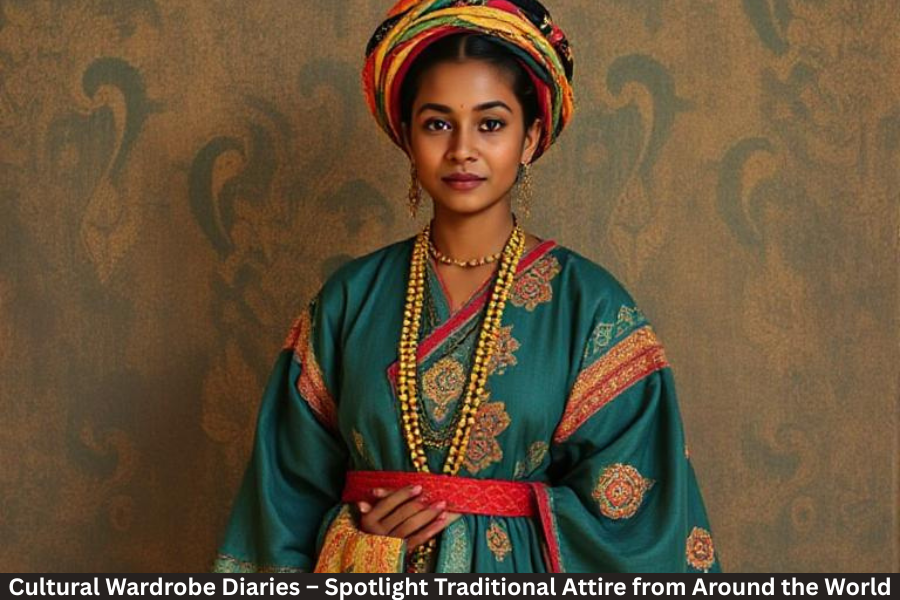Traditional attire is more than just attire-and it is a glance into the soul of a culture. Each stitch, fabric, and color tells stories passed down from generation to generation. Everything from ceremonial attire to everyday wear connects people further into history, identity, and community. Let us virtually journey with you around the continents to check out these wardrobes of culture and learn about their beauty and significance.
Asia
Japan-Kimono
Truly a Japan classic, the kimono is a long robe tied about the waist with an obi. It is worn during ceremonies, and festivals, and has various patterns and colors to indicate the season, occasion, or even a social standing of an individual with all its intricate folding and fabric-dyeing work to make it wearable art.
India – Sari and Kurta
In India, the two most dominant forms of traditional apparel are the sari and the kurta. The sari conveys the embroidery of the region with countless colors and its draping around the body; the kurta is more versatile and is worn with churidar or pajama by men and women for daily wear as well as for celebrations.
China – Qipao and Hanfu
Traditional clothes from China can range from the super elegant and tightly fitting qipao with its hallmark high collars to a looser-fitting style of Hanfu characterized by the flowing grace of wide sleeves and layered fabrics. Each apparel is a blend of symbolism, status, and art representing the dynastic period it originates from.
Africa
Nigeria – Agbada and Ankara
In Nigeria, Agbada, a flowing robe sewn for men to wear to formal occasions, is accompanied by highly embroidered caps. With Ankara prints, women celebrate culture with bold geometrical patterns expressing their taste and personality.
Kenya – Kitenge and Maasai Shuka
The Kitenge is colorful and patterned cloth used in everyday wear and celebrations. The Maasai Shuka, the red checks of bravery and fraternity, are often accessorized with beadwork and jewelry in the Maasai tribe.
South-Africa- Ndebele Attire
Ndebele attire is characterized by geometric designs, which are contrasted by bright colors. Beaded aprons and necklaces are traditionally worn by Ndebele women with designs that signify family designation, social standing, and life events.
Europe
Scotland-Kilt and Tartan
The Scottish kilt is woven from tartan patterns that carry clan histories. Every color combination stands for a particular family or region; therefore, kilts are used to express pride for the Scottish identity.
Spain-Flamenco Dress
Anathematised with garments that are adorned with ruffles and polka dots, trajes de flamenca grace theatres and festivals with their colors and excitement, underpinning the soul and rhythm of Andalusian culture.
Norway-Bunad
The bunad is a traditional attire of Norway frequently worn for national celebrations. Every style, from the period of embroidery to the color of the cloth, shall represent one Kent or town, with its cultural heritage preserved among its fabric.
Middle East
Saudi Arabia-Thobe and Abaya
In Saudi Arabia, the flowy robe is called `thobe’ for men. The ladies wear a type of elegant, black-colored cloak termed as `abaya’. Both types of apparel represent the cultural values in the very acceptable manner of modesty, elegance, and tradition.
Iran-Persian Robes and Chador
In Iran, the Persian robes and chadors evidence centuries of cultural evolution. Embroidery workmanship and patterning convey art heritage, social status, and regional representation.
Americas
Mexico-Charro Suit and Huipil
The Charro suit is worn by men and consists of deep embroidery and silver trimmings and was popularized in mariachi music performances. Local women wear the huipil, a handwoven blouse with symbolic patterns representing their local traditions.
Peru- Andean Poncho and Pollera
Andean ponchos are made from wool, with an array of dyeing processes using natural colour pigments. The pollera is a layered skirt recognizable to the Andean culture and is worn amid festivals with accompanying vibrant accessories and jewellery.
Native American-Regalia and Headdresses
Native American regalia involves the use of elaborate beadwork, feathers, and symbolic patterns. Headdresses are worn at ceremonies to indicate honour, bravery, and connection to nature spiritually.
Oceania
New Zealand-Māori Kākahu
Māori Kākahu are traditional cloaks, plaited from flax fibers together with feathers. Each cloak relates a story honoring the dead and marking great achievements.
Fiji-Sulu
The Fijian sulu is a wrap skirt worn by men and women. Brightly patterned and comfortable fabrics make its usage legal for everyday purposes or formal occasions.
Cultural Significance
Storytelling Through Patterns and Fabrics
Traditional attire communicates identity, history, and values. Their patterns largely present stories heritage, spirituality, and social status.
Ceremonial and Festive Garments
Many garments are reserved for weddings, religious ceremonies, and festivals, strengthening cultural continuity and community ties.
Modern Interpretations
Fusion Fashion Meets Contemporary Design
Designers have embraced mixing traditional patterns with modern cuts for a contemporary best that respects heritage in a global voice.
Conserving Heritage in a Fashion Industry
Such integration ensures a livelihood for cultures in modern fashion while at the same time introducing new generations to their roots.
Challenges to Preservation
Dilution of Culture Through Globalization
Due to mass efficient manufacture and westernized trend-setters, the protagonists of traditional apparel withstand their uniqueness as a footprint of culture.
Effort for Survival of Traditional Apparel
Museums, cultural programs, fashion fellowships all provide means for conserving and marketing traditional dress worldwide.
Conclusion
Traditional attire stands as a glowing symbol of the collective human story. Through the appreciation and preservation of traditional garments, we remember history, celebrate diversity, and keep cultures alive for many generations to come.
FAQs
Q1: What is the importance of traditional dress?
Traditional dress is the preservation of culture, history, and heritage while reflecting the social values and dichotomies and customs.
Q2: How are traditional dress upon amounts deregional?
By way of climate, history, religion, and local customs, a variation springs up and stands to create all over the world.
Q3: Does traditional attire affect modern fashion?
Traditional patterns, fabrics, and shapes find their way into modern fashion of several designers.
Q4: How can one help conserve traditional apparel?
Promote local artisans, take part in cultural activities, and promote knowledge through education and fashion.
Q5: Are traditional clothes worn today?
Yes, they are. They are worn at festivities, ceremonies, and increasingly as daily life in cultural expression.




